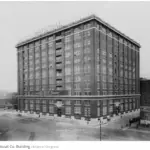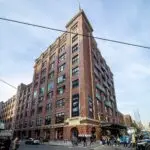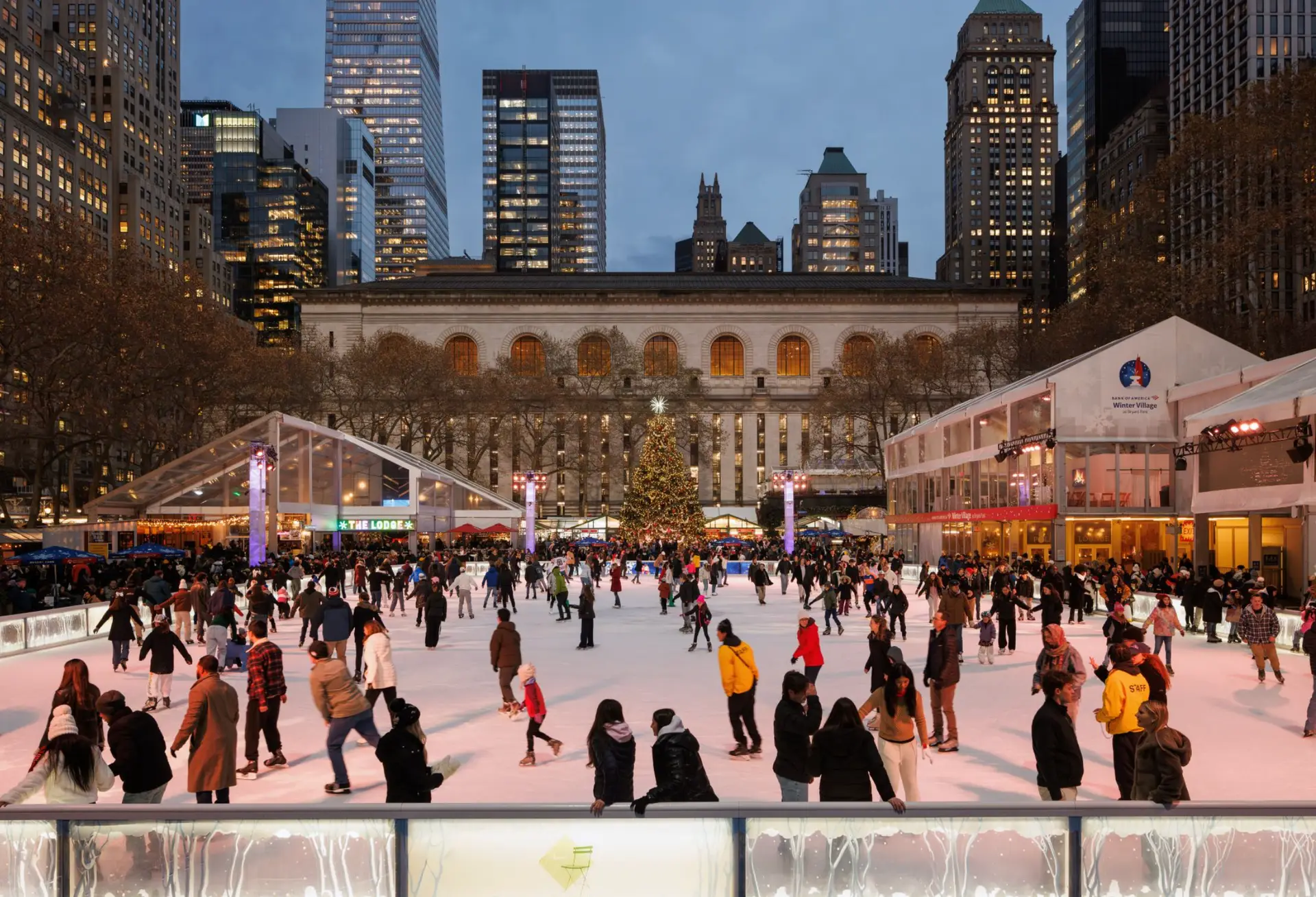Chelsea Market is a very popular mixed use development that opened in 1997. It is located in the Chelsea neighborhood of Manhattan in New York City. The Chelsea Market complex fills an entire city block bounded by Ninth and Tenth Avenues and 15th and 16th Streets, with a connecting bridge over Tenth Avenue to the adjacent 85 Tenth Avenue building, which was also part of the Nabisco complex but is now separately owned. The gound floor is filled with food vendors and shopping. The upper floors contain office space. Some very notable companies are located here: Oxygen Network, Food Network, MLB.com, EMI Music Publishing and our local New York City cable station NY1. Google bought the building in 2018 and has moved into some of the second, third, fourth, seventh, and eighth floors along with its subsidiary YouTube on the fifth.
From the market’s website: “Attracting 6 million national and international visitors annually, it is one of the most trafficked, and written-about, destinations of any kind in New York City. For both local foodies and international tourists, it’s entirely possible to enter the Market in the morning and not exit until lunchtime, without ever growing bored—and certainly without ever going hungry.”
Here are a few reasons why it has become so popular:
- History and Location: Chelsea Market is housed in the former National Biscuit Company (Nabisco) factory complex, which was built in the 1890s. The building’s architecture and industrial history make it an interesting and unique location for visitors.
- Variety of Food Options: Chelsea Market is home to a diverse range of food vendors, including seafood, Italian, Thai, Chinese, and Mexican cuisine, bakeries, coffee shops, and more. There is something for everyone, and the high-quality food and artisanal products draw people from all over.
- Shopping: In addition to the food vendors, Chelsea Market also features boutique shops, art galleries, and other retail stores. Visitors can find unique and interesting items that they may not find elsewhere in the city.
- Atmosphere: The market’s industrial architecture, high ceilings, and open floor plan create a bustling and lively atmosphere. It’s a great place to people-watch, grab a bite to eat, and soak up the energy of the city.
FUN FACTS:
Morimoto, owned by Food Network “Iron Chef” Masaharu Morimoto and designed by Japanese architect Tadao Ando, opened in January 2006 and operated on the 10th Avenue side for 15 years until 2020. The Food Network used to film its shows Iron Chef America and Emeril Live in the Chelsea Market complex.
There’s a 20,000 square foot YouTube Studio for creators with 10,000+ subscribers on the 6th Floor! It opened in 2014 and can be found by taking a semi hidden silver elevator – there is security to enter the elevator. The YouTube Space New York, as it’s called, is one of the spaces YouTube has opened worldwide in order to give creators a luxury studio to film content. The studio features some amazing sets including one that has legendary NYC rock club CBGB’s original walls, phone booth, and cash register!
From a Smithsonian Magazine article in 2018: When developer Irwin Cohen paid about $10 million for the foreclosed mortgage debt on the building in 1990, the thought of bringing tourists to that part of town was just a pipe dream. “When I came here, the history of the building: there were three murders in the basement,” Cohen described in a 2005 interview with the Center for an Urban Future. “You couldn’t walk here. It was controlled by prostitutes 24 hours a day.”



THE ABBREVIATED HISTORY (scroll down for the LONG version):
The building that now houses the market was originally constructed in the 1890s as the National Biscuit Company (Nabisco) factory complex. Nabisco produced a variety of baked goods, including Saltines and iconic Oreo cookie, in the building for many years.
In the 1950s, Nabisco moved production to a new facility in New Jersey, and the building was sold to various owners and tenants over the years. In the 1990s, a group of developers led by Irwin Cohen purchased the building and began renovating it into the current mixed-use space. The renovation preserved the building’s historic architecture and incorporated modern amenities, such as elevators and air conditioning.
Chelsea Market officially opened to the public in 1997, and it quickly became a popular destination for foodies and shoppers alike.
In March 2018, Google bought the entire building from real estate developers Jamestown, which acquired the building in 2003 and will continue to manage the popular food court on the ground floor. Google paid $2.4 billion for the building. Google had already paid $1.7 billion for the building across the street from Chelsea Market, in 2010.
Today, the market is home to a diverse range of food vendors. It also features boutique shops, art galleries, and other retail stores. Here is a sampling of the businesses that can be found at Chelsea Market:
- Food vendors: Chelsea Market is perhaps best known for its food hall, which features dozens of vendors selling a wide range of cuisine, from seafood to tacos to sushi to artisanal baked goods. Some of the popular food vendors include Los Tacos No. 1, Lobster Place, Doughnuttery, and Ninth Street Espresso.
- Retail shops: Chelsea Market is also home to a number of retail shops, including bookstores, clothing boutiques, and artisanal shops. Some of the popular shops include Artists & Fleas, Posman Books, Anthropologie, and Pearl River Mart.
- Offices: In addition to the food and retail spaces, the Chelsea Market building also houses a number of offices for various companies. Some of the businesses that have offices in the building include Major League Baseball, Google, Food Network, and EMI Music Publishing.
EAT YOUR WAY THROUGH CHELSEA MARKET WITH US ON OUR FOOD TOUR!
UNIQUE DESIGN ELEMENTS
Chelsea Market is a vibrant food hall and shopping center, but what many people may not know is hat much of the original architecture has been preserved to maintain the building’s character and charm. The complex consisted of several buildings, the largest of which was a 12-story brick structure that served as the company’s headquarters. The building was designed by architect Albert G. Zimmerman in a style known as “Romanesque Revival,” which was popular at the time.
When Nabisco moved out of the building in the 1950s, it sat vacant for decades. In the 1990s, a group of developers bought the building and began a massive renovation project to turn it into a modern office and retail space. But instead of tearing down the old building and starting from scratch, the developers chose to preserve many of the original architectural features.
One of the most striking features of the building is the exposed brick walls and industrial ceilings, which give the space a raw, gritty feel. The developers also kept many of the original wooden beams and columns, which were used to support the weight of the heavy machinery that was once used in the factory.
In addition to preserving the historic architecture, the developers also incorporated elements of the building’s past into the design of Chelsea Market. For example, the food hall is located in what was once the factory’s loading dock, and the original cobblestone pavement is still visible in some areas. The developers also installed several large murals that pay homage to the building’s industrial heritage.
The decision to preserve the original architecture of the building was a bold move, especially at a time when many developers were tearing down old buildings and replacing them with shiny new ones. But the developers of Chelsea Market understood the value of preserving historic buildings, both for their cultural significance and for their potential as unique retail and commercial spaces.
Chelsea Market History – The LONG Version:
GROWTH
In 1890, eight large bakeries joined to form the New York Biscuit Company. Soon after they acquired a dozen more bakeries. They began building a Romanesque-style complex on the east side of 10th Avenue, running from 15th to 16th Street, designed by Romeyn & Stever. Some of these buildings still survive today, the ones at midblock. They were competing with another consortium, the American Biscuit and Manufacturing Company in Chicago. The rivalry was hurting business, so in 1898 they combined to form the National Biscuit Company. Soon they were supplying half the biscuit production in the United States. Then they bought Uneeda Biscuit in 1898. They were producing Fig Newtons, Vanilla Wafers, Saltines, Barnum’s Animal Crackers. In 1913, the Oreo was created at the Chelsea facility followed by the Mallomar.
An 11-story, full block building was constructed in 1913 – extending from 10th to 11th Avenue and 15th to 16th Street. It was built on a landfill and they found the chain, anchor and timbers from a very old two-master schooner during excavation! An overhead pedestrian bridge was erected to join the main complex with an outlying property that was purchased (the American Can Company building at 447 West 14th Street).
In 1932, some of the main building was replaced with an unusual structure – a huge open “porch” on the second and third floors to accommodate an elevated freight railroad. The railroad tracks still exist today and of course the elevated railroad was turned into the present day landmark the High Line. The same architect, Louis Wirsching Jr., designed the aluminum-covered Art Deco pedestrian bridge that connected the two buildings across 10th Avenue.
DECLINE:
In 1958, the National Biscuit sold the complex – 22 buildings, 2 million square feet – to Louis Glickman, an investor. Most of the production had been moved to New Jersey. In the 1970s and 1980s there were few phone numbers listed. The area was in decline.
PRESENT DAY:
In the 1990s, investor Irwin Cohen organized a fund to buy the buildings from Ninth to 11th Avenues and 15th to 16th Street. Over the next several years, the buildings were modernized.



